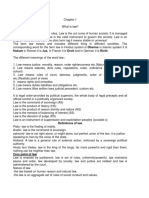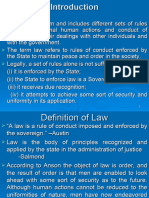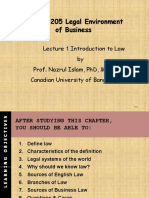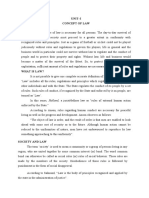BRF NOTES
1
� UNIT 1
CHAPTER 1: INTRODUCTION TO BUSINESS LAWS
Definition of Law
Law refers to a body of rules and principles that regulate human conduct and are
enforced by the sovereign authority of the state.
It acts as a social control mechanism to maintain peace, justice, and order in society.
Law defines what is right and wrong, and violations of law attract penalties or legal
sanctions.
It ensures uniformity, predictability, and fairness in society and business relations.
According to Salmond, law is “the body of principles recognized and applied by
the state in the administration of justice.”
John Austin’s Definition: "A Law is a rule of conduct imposed and enforced by
the sovereign."
Definition as per the Constitution of India:
"Article 13(3)(a) of the constitution of India states 'Law' very broadly by an
inclusive definition. It does not expressly include only a law enacted by the country's
legislative assembly, an enactment is obviously a law but it also includes other
attributes. Therefore, the definition of law includes following —
1. An ordinance, because it is made in the exercise of the legislative powers of the
executive.
2. An order, bye law, rule, regulation, and notification having the force of law,
because ordinarily they form the category of subordinate delegated legislation and are
not enacted by the legislature.
3. Custom or usage having the force of law, because they are not enacted by law at all.
So, we can say that, law simply mean law which are enacted in the country’s legislative
assembly."
S.No Form of Law Description Relevance under
Article 13(3)(a)
1 Ordinance An ordinance is a temporary law Even though not a
promulgated by the President regular enactment, it is
(Article 123) or Governor included under the
(Article 213) when the legislature definition of “law” in
is not in session. It is not passed Article 13(3)(a).
by Parliament/Assembly, but has
2
� the same force as an Act during
its validity.
2 Subordinate / Includes instruments like: These are forms of
Delegated delegated legislation
Legislation and are considered
• Rules (e.g., Rules under the “law” under Article
Companies Act, e.g., Companies 13(3)(a) due to having
(Audit and Auditors) Rules) legal force.
• Bye-laws (e.g., framed by
municipalities)
• Notifications (e.g., tax
exemptions issued by ministries).
Order - A specific direction
issued by a govt, Court to
enforce a law (e.g- Supreme
Court order)
Regulation- A broader
framework or guideline to
control specific activities or
sectors (SEBI (Listing
Obligations and Disclosure
Requirements) Regulations,
2015)
These are not enacted by
legislature but derive authority
from parent laws.
3 Custom or Refers to long-established Even though not
Usage Having practices accepted by courts as formally enacted, they
the Force of binding (e.g., customs in family law are included under
Law or trade). They are not legislated, “law” if they have the
but are recognized and followed. force of law, as per
Article 13(3)(a).
Definition of Business Law
Business Law is the branch of law that deals with the rights, relations, and conduct of
persons and businesses engaged in commerce, trade, merchandising, and sales.
It is also called Commercial Law or Mercantile Law.
Business law regulates areas like:
Topic Governing Indian Law
Contracts Indian Contract Act, 1872
3
� Sale of Goods Sale of Goods Act, 1930
Partnership Indian Partnership Act, 1932
Limited Liability Limited Liability Partnership Act, 2008
Partnership
Negotiable Negotiable Instruments Act, 1881
Instruments
Insurance Insurance Act, 1938Insurance Regulatory and Development
Authority Act, 1999 (IRDAI)
Insolvency Insolvency and Bankruptcy Code, 2016 (IBC)
Carriage of Goods Carriers Act, 1865Indian Railways Act, 1989Multimodal
Transportation of Goods Act, 1993
Arbitration Arbitration and Conciliation Act, 1996
Business Law ensures transparency, accountability, and legal certainty in
commercial operations.
It protects the interests of entrepreneurs, investors, employees, and consumers.
Knowledge or Awareness of Law and Its Importance
Ignorance of law is not an excuse.
One cannot plead ignorance for breaching the law or not following rules.
Example: If Mr. X travels without a valid train ticket, he cannot defend himself by
claiming ignorance of ticket rules.
Importance and necessity of knowledge of law:
1. To provide social security for all people.
2. To regulate external human behaviour.
3. To protect social as well as individual assets.
4. To provide social as well as individual services in different fields.
5. To monitor financial propriety.
6. To maintain social code of conduct.
The Sources of Indian Business Law
The main sources of Indian Business Law are as follows:
1. English Mercantile Law
English Laws are the primary sources of Indian Mercantile Law.
English Laws are based on customs and usages of merchants in England.
In the absence of provisions regarding any matter of the Indian Law or where there is
ambiguity, the Indian Courts generally take recourse to the English Law.
2. Statutes of the Indian Legislatures
4
� The legislation is the main source of law in India.
The Central and the State Legislatures possess law-making powers and have exercised
these powers extensively.
E.g., Indian Contract Act, 1872; NI Act, 1881; Sale of Goods Act, 1930; Companies
Act, 2013
3. Judicial Decisions or Precedents
The past judicial decisions of English Courts and Indian Courts are also one of the
sources of law.
Whenever the law is silent on a point, the judge has to decide the case according to
the principle of equity, justice, and good conscience.
The past judicial decisions are referred to and followed by the Courts while deciding
similar cases.
4. Custom and Usages
A customary rule is binding where it is ancient, reasonable, and not opposed to any
Statutory rule.
A custom becomes legally recognised when it is accepted by the Court and is
incorporated in a judicial decision.
5
� CHAPTER 2: JURISPRUDENCE
Concept of Jurisprudence
The term ‘Jurisprudence’ is derived from Latin: ‘Juris’ meaning law and
‘Prudentia’ meaning knowledge or skill.
Etymologically, it means knowledge or science of law.
Jurisprudence today refers to the philosophy and theory of law, a discipline that
investigates the foundational principles of law.
Definitions:
G.W. Paton: It overlaps social sciences and philosophy, digging into history and
structuring chaotic legal systems into order.
Salmond: It is an abstract and theoretical investigation into law, aiming to expose
essential legal principles.
Unlike practical legal subjects (contracts, torts), jurisprudence emphasizes conceptual
analysis rather than rules.
Jurisprudence Helps Us:
1. Develop an intrinsic interest in legal reasoning.
Cultivate a deep and genuine curiosity for understanding how legal principles evolve,
operate, and influence real-life judicial decisions.
2. Apply legal thought across disciplines (medical, political, social).
Utilize legal analysis to interpret and resolve issues across diverse fields like medicine,
politics, and sociology, highlighting law's interdisciplinary relevance.
3. Analyze legal systems through a unified conceptual framework.
Examine the structure and function of legal systems by identifying common theoretical
foundations that unify different branches of law.
4. Move beyond strict adherence to precedent, becoming more socially conscious.
Encourage a dynamic approach to legal interpretation that considers contemporary
social needs rather than rigidly following outdated precedents.
5. Escape excessive formalism.
Avoid mechanical application of rules by embracing a more thoughtful and contextual
method of legal interpretation.
6. Enhance legal arguments through logical and philosophical clarity
Improve the quality of legal discourse by applying refined conceptual tools that bring
precision and depth to legal reasoning.
6
�Nature and Scope of Jurisprudence
Jurisprudence now encompasses state and social order, expanding beyond its
traditional limits.
Salmond distinguishes:
o Generic sense: Includes all legal doctrines (entire body of law).
o Specific sense: Focuses on philosophy/theory of law, broken into three
branches:
Analytical Jurisprudence
Historical Jurisprudence
Ethical Jurisprudence
Theories/Branches of Jurisprudence
Analytical Jurisprudence
Associated with John Austin (Austinian School / Positive School).
Studies law as it exists, not how it ought to be.
Regards law as a command of the sovereign, enforced by sanctions.
Analyzes components like state, sovereignty, rights, and duties.
Historical Jurisprudence
Emphasizes evolution of law through customs and social practices.
Law is not created by the state but emerges from customs, according to Savigny and
others.
Studies the origin and development of legal ideas.
Ethical Jurisprudence
Focuses on law as it ought to be – a normative approach.
Intersects moral and legal philosophy.
Without ethical values, law becomes rigid and mechanical.
Believes in justice as an inseparable element of law.
Three Core Enquiries in Jurisprudence
1. Legal Rules:
o Explores what makes a rule a legal rule vs. morality or etiquette.
o It reflects on rules already known, like a philosopher analyzes scientific laws.
2. Legal Concepts:
o Analyzes abstract ideas like rights, duties, negligence, intention, ownership,
possession, etc.
o Builds a conceptual structure of legal thought.
7
� 3. Legal System:
o Examines authority, precedent, codification, and judicial reasoning.
o Includes topics like ratio decidendi, statutory interpretation, and hierarchies
of courts.
Definitions by Eminent Jurists
Roman Jurist Ulpian:
Jurisprudence is “the observation of things divine and human, the science of the just and
unjust.”
British Jurist Sir Thomas Erskine Holland:
“Jurisprudence is the formal science of positive law.”
It is the formal science of those relations of mankind which are generally recognized as having
legal consequences.
Salmond:
“In a generic and primary sense jurisprudence includes the entire body of legal doctrine.”
It is jurisprudentia – the knowledge of law – and in this sense, all law books are books of
jurisprudence.
K.C. Allen:
“Jurisprudence is the scientific synthesis of all the essential principles of Law.”
Purpose and Function of Law
Purpose:
Law is a means to an end — primarily justice and order.
Salmond: Law is a body of principles applied by the state to administer justice.
Roscoe Pound’s purposes:
1. Maintain order.
2. Preserve status quo.
3. Maximize individual liberty.
4. Satisfy the needs of society.
Functions:
A tool for social engineering (Pound).
Facilitates dispute resolution, social control, and enforcement of rights.
Encourages freedom, justice, and orderly interaction.
In business, law aids in compliance, contracts, and governance.
8
� Types of Law (As per Salmond)
Type Description
Natural/Moral Law Based on principles of justice, morality, reason; also known as
divine or unwritten law.
Conventional Law Agreed upon rules (e.g., club rules, sports rules); may overlap
with civil law.
Physical/Scientific Uniformities of nature (e.g., gravity, political economy laws);
Law expresses what is, not what ought to be.
Civil Law Law of the land or state; governs relationships among
individuals.
Practical/Technical Rules to achieve goals (e.g., health, architecture).
Law
Customary Law Rules derived from long-standing practices and customs
voluntarily observed.
International Law Rules governing relations between states; both customary and
conventional.
Imperative Law Commands from a sovereign authority backed by sanctions
(Austinian view).
Classification of Law
Broad Division:
1. National/State Law International Law
Within National Law:
Public Law Private Law
Regulates state structure & public matters Governs relationships between individuals
Sub-divisions:
Public Law:
o Constitutional Law: Structure and fundamental principles of the state.
o Administrative Law: Powers and procedures of administrative bodies.
o Criminal Law: Defines offences and prescribes punishments.
Constitutional Law
Constitutional Law refers to the body of legal rules that define and structure the
constitution of the state.
9
� It determines the fundamental organization and framework of the state, setting out
essential institutions and their functions.
Although modern states are complex, constitutional law generally comprises:
o Fundamental elements (e.g., sovereignty, division of powers, rights of
citizens).
o Detailed provisions concerning state structure and operational mechanisms.
Constitutional law provides the basic rules of recognition for the legal system; that is,
it lays down the authority from which other laws derive their legitimacy.
Importantly, the Constitution is not derived from existing laws—it stands as the
foundational source.
In some cases, it may provide mechanisms for its own amendment or replacement,
but this is not universally present.
Courts, legislatures, and all laws derive their authority and legitimacy from the
Constitution.
2. Administrative Law
Administrative Law governs the structure, powers, and functions of the executive
and administrative bodies of the government.
It regulates:
o Powers granted to administrative authorities.
o Limits and boundaries of those powers.
o Procedural methods used in implementing administrative actions.
This branch of law aims to check arbitrary or abusive exercise of power by
administrative authorities.
It provides legal remedies to individuals whose rights are violated or adversely affected
by administrative decisions or actions.
Thus, administrative law acts as a mechanism of control over public administration,
ensuring accountability and legality in governance.
3. Criminal Law
Criminal Law defines various offences and prescribes punishments for such acts.
Its primary aim is:
o To prevent crime.
o To punish offenders.
It plays a crucial role in maintaining law and order, and ensuring peace and stability
within society.
Criminal law is enforced by the state, and prosecution is usually initiated by the
government on behalf of society.
Examples include laws against murder, theft, assault, corruption, and cybercrime.
10
� Private Law:
o Law of Persons, Property, Obligations (e.g., Contracts, Torts, Quasi-Contracts).
o Courts adjudicate private disputes; state acts as neutral arbiter.
Private Law
Private Law regulates the relationships between individuals or private entities.
Unlike public law, which governs the state's relationship with individuals, private law
focuses on:
o Contracts
o Property disputes
o Torts (civil wrongs)
o Personal matters like marriage and inheritance
Disputes under private law are resolved by judicial organs of the state (i.e., courts).
The state acts as a neutral adjudicator, not as a party to the dispute.
It applies to citizens, businesses, and organizations, guiding lawful interactions and
enforcing obligations and rights between them.
11




















































































